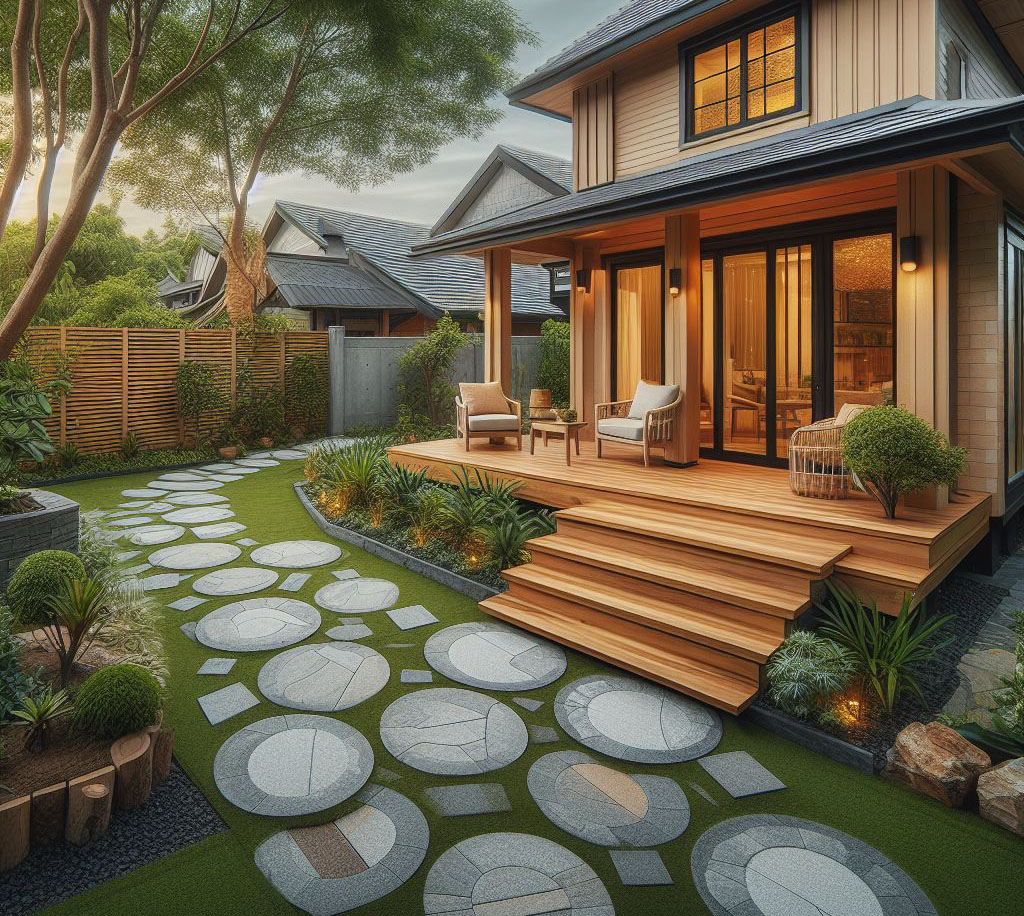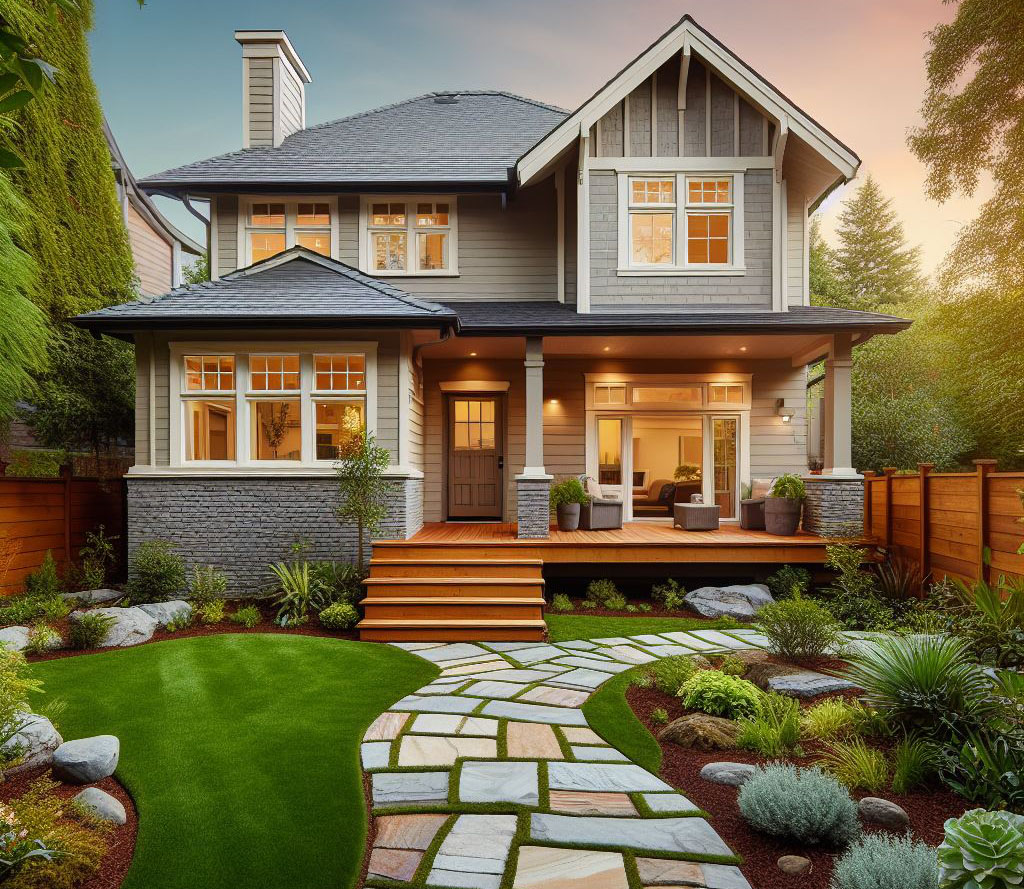A walkway is more than a mere passage from one area to another, it’s a functional, aesthetic element that shapes the character and accessibility of your home. Much like a well-constructed narrative, a thoughtfully designed walkway adds coherence and charm to your property’s story. It’s not only about creating an inviting path, it’s also about managing land drainage, preserving your lawn, and enhancing your property’s safety and curb appeal.

Understanding the Basics of Walkway Construction
Groundwork Essentials
Embarking on the journey of constructing a walkway requires a thoughtful approach, beginning with a solid foundation. It’s paramount to ensure stability and longevity, much like the cornerstone of a sturdy building. This stage is about meticulously preparing the ground to prevent future shifting or cracking.
Material Considerations
Selecting the right material is akin to choosing the perfect fabric for a bespoke suit. It needs to withstand the elements, maintain its allure over time, and reflect the style of your home. Consider materials that balance durability and aesthetics, able to withstand the whims of nature while contributing to the visual harmony of your property.
Essential Tools and Attire
Preparing for walkway construction is similar to gearing up for a challenging but rewarding expedition. Equip yourself with robust gloves, sturdy boots, and the right set of tools—shovels for excavation, tampers for soil compaction, and perhaps a plate compactor for a professionally finished base.

Material Selection for Your Walkway
Comparing Options
- Concrete: It’s the reliable protagonist in many construction stories, known for its versatility and endurance. While it may seem mundane, it can be transformed into a masterpiece with the right creative touch, such as adding colors or patterns.
- Pavers: Think of pavers as the building blocks of your walkway’s personality. They offer a myriad of design possibilities, allowing for personal expression and creative patterns. Though they require a bit of puzzling to align, their ability to be replaced individually adds a practical advantage.
- Natural Stone: This material brings a piece of the earth’s narrative to your doorstep, with each stone having its own history and character. It’s a premium choice, offering unmatched natural beauty but demanding a higher investment and thoughtful placement.
- Gravel: Gravel is the good of walkway materials—unpretentious, cost-effective, and straightforward. While it offers a simple solution, it needs careful containment and might not be the best companion for snowy climates.

Making the Choice
Deciding on a material is a process of aligning your budget, maintenance willingness, and aesthetic aspirations. Concrete stands as the economical, all-rounder option, while natural stone is the investment piece, offering timeless beauty with a price tag to match. Pavers strike a balance, offering versatility without breaking the bank, and gravel, though low-cost, comes with considerations regarding maintenance and practicality.
In crafting your walkway, the materials and methods you choose narrate the story of your home. With thoughtful planning and a keen eye for detail, your walkway can be more than a pathway—it can be a landmark in your property’s landscape, inviting admiration and exploration. Stay on this path, and let’s continue paving the way to a beautifully constructed walkway.

Creative Sidewalk and Walkway Design Ideas
In the realm of home renovation and construction, a well-conceived walkway does more than guide your steps, it accentuates your home’s character. It’s about crafting a narrative that complements the architecture and the surrounding landscape.
- Material Symphony: Combining materials can bring harmony to your design. Consider how the rustic charm of brick borders can elegantly frame the rugged beauty of gravel, creating a contrast that is both visually striking and functionally robust.
- Pattern Play: Infuse life into your walkway with patterned arrangements. A herringbone or basketweave pattern doesn’t just lay the ground, it weaves a story underfoot, inviting a moment of appreciation with every step.
- Landscaping Liaison: Integrate your walkway with the surrounding flora. Planting complementary shrubbery or vibrant flowers along the path creates a dialogue between the hardscape and the landscape, crafting a cohesive scene that captures the eye and the imagination.
- Palette and Texture: Engage with color and texture thoughtfully. A slate walkway flanked by lush moss can create a stunning visual interplay, while the tactile contrast between rough stone and smooth granite adds a layer of sophistication and sensory appeal.

Step-by-Step Guide to Building Your Walkway
Building a walkway is a journey of precision, patience, and attention to detail. Each step, from planning to maintenance, is a critical chapter in the story of creating a durable and aesthetically pleasing pathway.
- Precision Planning: Start with a clear, well-thought-out plan. Detailed measurements and a comprehensive design will serve as your roadmap, ensuring every element aligns perfectly with your vision.
- The Art of Excavation: Approach excavation with care. It’s the stage where you shape the earth to lay the foundation of your walkway. Depth is key here – consider the thickness of both the base material and the walkway material to ensure stability and longevity.
- Foundational Integrity: A robust base is critical. A well-compacted gravel base sets the stage, providing the stability and drainage needed to preserve the walkway’s structure and appearance over time.
- Meticulous Material Placement: Laying the walkway material is where your vision starts to materialize. Whether working with pavers, stones, or concrete, precision in placement ensures a flawless finish that resonates with elegance and durability.
- Finishing with Finesse: Details matter. Sealing pavers or stones and ensuring joints are properly filled will not only enhance the walkway’s aesthetic but also its resilience against the elements and time.
- Dedication to Maintenance: A walkway is a living part of your home, evolving with the seasons and time. Regular cleaning, sealing, and monitoring for potential issues are paramount in preserving its beauty and functionality.
Innovative Features to Enhance Your Walkway
Drawing on a wealth of construction experience, it’s clear that a walkway serves not just as a functional path but as a focal point of your home’s exterior. Let’s infuse it with elements that elevate both its utility and charm.
- Strategic Lighting: Properly placed lighting can transform your walkway, offering both safety and an enchanting ambiance. Consider solar-powered or low-voltage options for an energy-efficient solution that highlights your walkway’s best features after dusk.
- Seating Solutions: Incorporating seating along your walkway invites pause and reflection. Whether it’s a bench nestled among the flowers or built-in seating, these restful spots can turn a simple path into a serene retreat within your garden.
- Water Features: The addition of a water element like a small backyard fountain or a birdbath introduces a dynamic and soothing aspect to your walkway. The gentle sound of water can create a tranquil atmosphere, enhancing the sensory experience of your outdoor space.
- Defining with Borders: Edging your walkway with thoughtful materials such as natural stone, brick, or decorative metal can sharply define its boundaries, keeping your pathway distinct and well-maintained amidst the lushness of your garden.

Common Challenges and Solutions
Even the most meticulously planned projects can encounter challenges. With a keen eye and a problem-solving mindset, these hurdles can be gracefully overcome.
- Mastering Drainage: Adequate drainage is essential. Ensure your walkway is slightly sloped away from structures to prevent water accumulation. For persistent issues, a French drain or the use of permeable paving materials can offer effective solutions.
- Tackling Uneven Terrain: Uneven ground requires a thoughtful approach. A solid base layer of crushed stone and sand can provide a stable foundation, ensuring your walkway remains level and enduring.
FAQ Section
While gravel and crushed stone are initially cost-effective, consider their maintenance requirements. Pavers and concrete, though more of an investment upfront, offer durability and lower long-term maintenance, potentially providing greater value over time.
A minimum width of 36 inches is recommended for comfortable passage. If space allows, a 48-inch width can create a more inviting and accessible walkway.
Opt for materials with textured surfaces to provide traction underfoot. Regular upkeep, including the removal of snow and debris, is essential for maintaining a safe walkway throughout the year.
With careful planning, the right materials, and a thorough understanding of the process, a durable and aesthetically pleasing walkway is certainly within the reach of a well-prepared DIY enthusiast.
